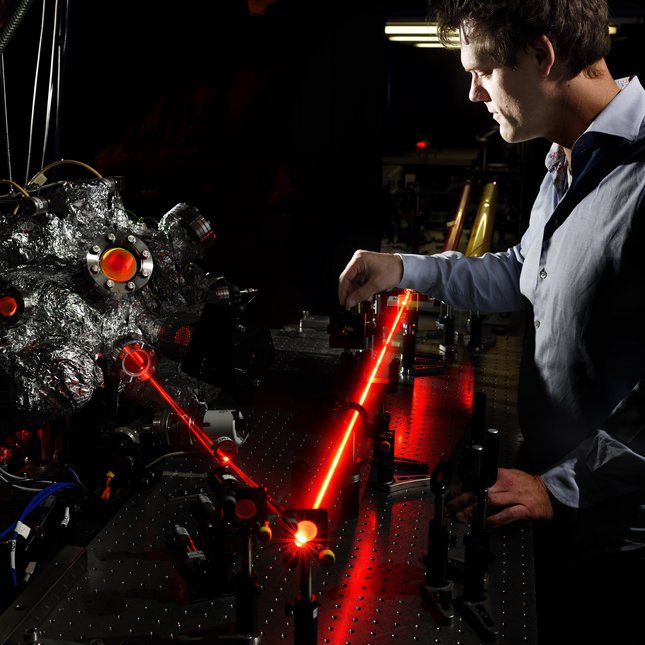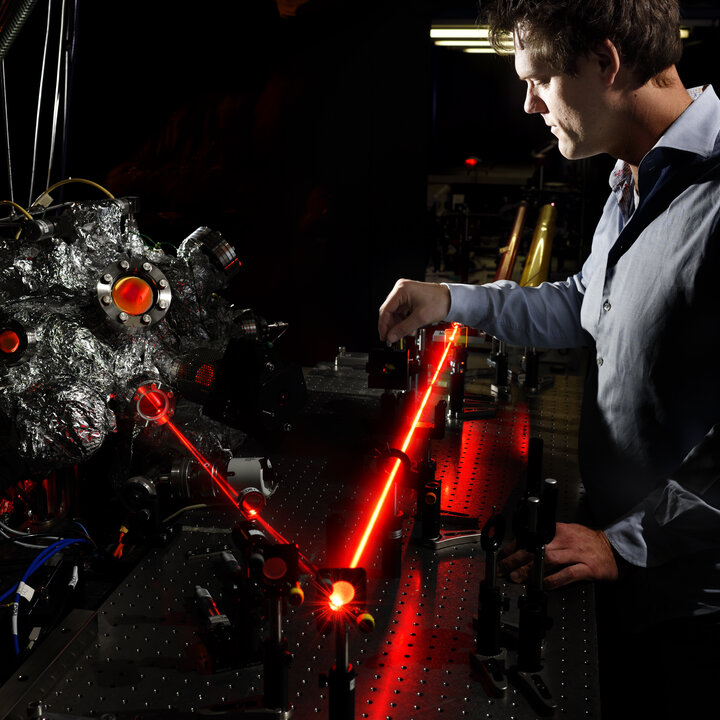
One major aim of our group is to understand the underlying mechanisms during ultrathin film growth which is then put to use to obtain fine control over the growth processes and the properties of the films. We use a combination of experimental and modelling approaches to enhance our understanding of the gas-surface interactions and surface processes taking place during thin film growth. The simultaneous application of both experiment and theory in the group gives us a much clearer understanding of the growth processes than either experiment or theory alone. Currently the focus of our research is mainly on film growth by atomic layer deposition (ALD).
Nonlinear surface spectroscopy
In addition to conventional linear optical techniques such as in situ infrared absorption spectroscopy (e.g. by Fourier transform infrared spectroscopy), our group also develops nonlinear optical techniques like broadband sum-frequency generation (BB-SFG) and second-harmonic generation (SHG). These techniques are used ex situ and in situ to obtain information complementary and inaccessible to linear techniques, giving new insights into the ALD growth and thin film properties.
BB-SFG is a laser based technique, new to the field of ALD, probing a part of the vibrational fingerprint of the IR region (bandwidth ~100 cm-1). BB-SFG uses typically a femtosecond infrared laser pulse in combination with a picoseconds visible laser pulse leading to radiation at the sum frequency. BB-SFG can detect surface groups involved in ALD growth such as -OH and –CH 'background-free', with a high sensitivity and at short integration times (1-100 sec. compared to the 10-30 min. required for FTIR). Moreover, the surface selective nature of BB-SFG is uniquely suited for the study of the ALD surface chemistry in which surface groups can be monitored accurately.
SHG is used to study the electronic structure of interfaces, for example, those between thin films and of crystalline silicon. The method is similar to SFG but now with two identical photons (from the same laser source) in the visible domain. SHG can probe electronic transitions in materials and at surfaces and measure for example internal electric fields in silicon caused by charges in metal-oxides deposited by ALD on top of the silicon. Especially the contactless, optical measurement of electrical fields is highly relevant in the development of modern semiconductor devices for applications in nanoelectronics and photovoltaics.
Atomistic modelling
The last decade has seen a phenomenal increase in the use of first-principles based density functional theory (DFT) to understand material properties both in the bulk and at surfaces. To exploit this potential of first-principles based atomistic modelling we started both in-house research and a close collaboration with Tyndall National Institute in Ireland which is at the forefront of applying atomistic modelling to thin film growth processes. Using first-principles based atomistic modelling accurate information difficult to obtain from experiments can be made accessible. For example, adsorption geometries of reactants and products, reaction transition states, activation energy barriers to diffusion on surfaces can be obtained (see figure below). Moreover, activation energy barriers of elementary reactions in a proposed reaction mechanism can be calculated and used to verify the plausibility of a proposed mechanism.
One major aim of our group is to understand the underlying mechanisms during ultrathin film growth which is then put to use to obtain fine control over the growth processes and the properties of the films. We use a combination of experimental and modelling approaches to enhance our understanding of the gas-surface interactions and surface processes taking place during thin film growth. The simultaneous application of both experiment and theory in the group gives us a much clearer understanding of the growth processes than either experiment or theory alone. Currently the focus of our research is mainly on film growth by atomic layer deposition (ALD).
Nonlinear surface spectroscopy
In addition to conventional linear optical techniques such as in situ infrared absorption spectroscopy (e.g. by Fourier transform infrared spectroscopy), our group also develops nonlinear optical techniques like broadband sum-frequency generation (BB-SFG) and second-harmonic generation (SHG). These techniques are used ex situ and in situ to obtain information complementary and inaccessible to linear techniques, giving new insights into the ALD growth and thin film properties.
BB-SFG is a laser based technique, new to the field of ALD, probing a part of the vibrational fingerprint of the IR region (bandwidth ~100 cm-1). BB-SFG uses typically a femtosecond infrared laser pulse in combination with a picoseconds visible laser pulse leading to radiation at the sum frequency. BB-SFG can detect surface groups involved in ALD growth such as -OH and –CH 'background-free', with a high sensitivity and at short integration times (1-100 sec. compared to the 10-30 min. required for FTIR). Moreover, the surface selective nature of BB-SFG is uniquely suited for the study of the ALD surface chemistry in which surface groups can be monitored accurately.
SHG is used to study the electronic structure of interfaces, for example, those between thin films and of crystalline silicon. The method is similar to SFG but now with two identical photons (from the same laser source) in the visible domain. SHG can probe electronic transitions in materials and at surfaces and measure for example internal electric fields in silicon caused by charges in metal-oxides deposited by ALD on top of the silicon. Especially the contactless, optical measurement of electrical fields is highly relevant in the development of modern semiconductor devices for applications in nanoelectronics and photovoltaics.
Atomistic modelling
The last decade has seen a phenomenal increase in the use of first-principles based density functional theory (DFT) to understand material properties both in the bulk and at surfaces. To exploit this potential of first-principles based atomistic modelling we started both in-house research and a close collaboration with Tyndall National Institute in Ireland which is at the forefront of applying atomistic modelling to thin film growth processes. Using first-principles based atomistic modelling accurate information difficult to obtain from experiments can be made accessible. For example, adsorption geometries of reactants and products, reaction transition states, activation energy barriers to diffusion on surfaces can be obtained (see figure below). Moreover, activation energy barriers of elementary reactions in a proposed reaction mechanism can be calculated and used to verify the plausibility of a proposed mechanism.
